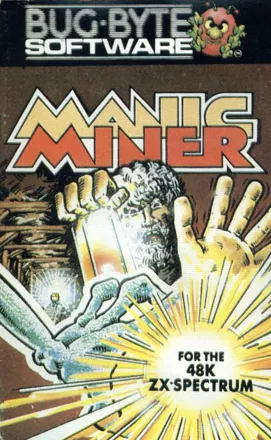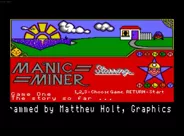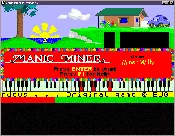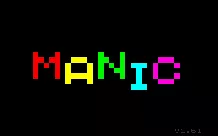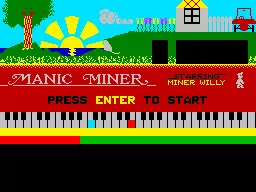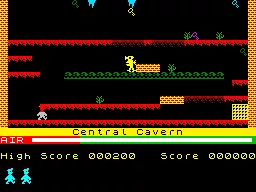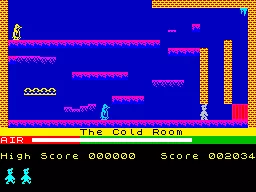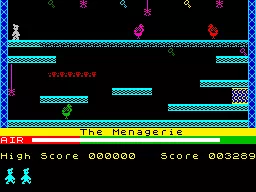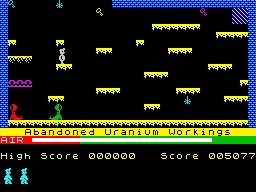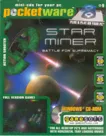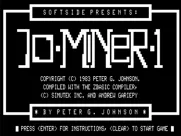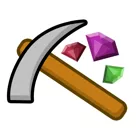Manic Miner
Description official description
You play the role of Miner Willy, a bold explorer and adventurer. He discovers a network of underground caverns used by an advanced but now extinct civilization, and realizes that the mines contain lucrative metal ores. Through 20 caverns, Willy must collect all treasures before the time (air) runs out, watching out for the nasty guardians, the obstacles, long falls, quicksands and all elements to be found in a classic platform game.
The game is linear, and each room's exit only becomes available once all the items have been collected. Close contact with an enemy or stationary hazard, or falling a great distance, causes the player to lose a life and restart the level.
Groups +
Screenshots
Credits (ZX Spectrum version)
| Author |
Reviews
Critics
Average score: 73% (based on 35 ratings)
Players
Average score: 3.9 out of 5 (based on 67 ratings with 3 reviews)
The Good
If you owned a ZX Spectrum back in the day, chances were you heard of Manic Miner created by Matthew Smith. There were actually two versions of the game for the Speccy. The first was from Bug-Byte, who offered Smith Sinclair's machine in an exchange contract for three games. One of these was Manic Miner, which took Smith eight weeks to complete. Later, he re-released the game through his new company called Software Projects, and ports were made to popular eight-bit computers.
I was impressed with this game from the get-go. A nice rendition of “The Blue Danube” is played while the game highlights which keys are pressed. This is a great way to teach people how to play Strauss’s classical piece. Scrolling text appears when the piece finishes playing; if you let this run this course, you see a preview of all twenty screens.
You control Miner Willy as he collects a number of treasures in each scene and make your way to the exit without touching any of the enemies, which include poisonous pansies, mutant telephones, Pac-Men on legs, spiders, slime, and robots. Since Willy has no weapon to defend himself with, he has to jump over them. Most of these enemies, except one or two, do not make an appearance again in the game. Contact with any enemies results in a loss of one of your lives. In true Monty Python fashion, losing all your lives results in Willy being placed on a pedestal so he can be crushed by a big boot that appears from the top of the screen.
Graphic-wise, the outdoor scene above the keyboard on the title screen looks fantastic and it serves as your escape route. There is no ending when you reach this; the game loops you back to the first scene. I like how each screen is composed of various colors so that it doesn’t get boring. The exit to the next scene consists of different designs that look good. The animations are impressive as well. Sound-wise, you play the game to “In the Halls of the Mountain King” which loops as long as you don’t run out of lives and stay in the game. The only effects heard are jumping sounds and the restarting of the screen.
The Bad
I can’t think of anything.
The Bottom Line
I like the simplicity that Manic Miner offers. Just collect each treasure in all twenty screens without coming into contact with any enemies. That's all there is to it. The graphics and animation are spot on, and the renditions of two classical music pieces are a joy to listen to.
Commodore 64 · by Katakis | カタキス (43085) · 2022
Roy Coates' loving adaption of the classic game, and not before time!
The Good
Well its Manic Miner, iconic game of the 1980s, and it was finally available on the Dragon in 1984. For those not familiar it is probably the poster child for platform games developed for the home computer, most versions being approximately 20 screens of fiendish but highly addictive and slightly otherworldly fun. Roy Coates' version was a masterful adaption- he was a great writer for the machine for many years and an enthusiastic contributor to Dragon User magazine, and the adaptation being done by someone who genuinely loved the machine clearly shows through. Frankly Dragon owners were desperate for many of the games their mates had on the more popular machines and would have bought anything regardless of quality, so it is a real boon to find that the game has been put together so well. Despite the lack of memory compared to the 48 K Spectrum, Roy actually manages an extra couple of screens. Hi Res mode is of course black and white only for the PAL systems, but it does look beautiful. It works just as well on NTSC artifacted systems, and the sound effects are highly effective, almost as good as the Commodore 64 version. The collision detection is excellent, the gameplay smooth and the game is damn near flawless.
The Bad
As ever with Miner there is an ability to lose all your lives at once, a common flaw to almost every version I have played (although I have not played them all). I would have liked the monochrome green mode to be a colour option, and of course it came with dreaded and fiddly software protection.
The Bottom Line
Manic Miner- the grand-daddy of the platform game, done perfectly for the machine.
Dragon 32/64 · by drmarkb (105) · 2016
Take a shine / to Manic Mine / ur
The Good
Manic Miner is a platform game for the 48k Sinclair Spectrum. It was inspired by a contemporary Atari 400/800 title called Miner 2049er, which was in turn based on the arcade game Space Panic, perhaps the first platform game of all. Manic Miner was more sophisticated than either title. It had collapsing floors, laser beams, a wide variety of enemies, and jumping! Space Panic did not have jumping. Manic Miner was not available for the 16k Sinclair Spectrum, and it was one of the best reasons to upgrade.
Manic Miner is a key step in the evolution of the British/Spanish platform game, although it is quite obscure outside Britain and Spain on account of it only being available for the Sinclair Spectrum. It was however widely converted to other platforms during the 1990s, although most of these conversions improved the graphics and added scrolling, which tarnished some of the game's appeal. Nowadays it is commonly available as a Java applet, or freely-downloadable from Worldofspectrum. I believe there is a conversion for the Game Boy Advance.
Modern platform games - perhaps a contradiction - are not like Manic Miner, although portions of its gameplay style are present in the Tomb Raider series. Specifially, Manic Miner is a hybrid platform/puzzle game, in that it is not about reflexes and skill, it is instead a test of pattern memorisation and the player's ability to accurately perform a sequence of moves to a timeline. Each screen has a route, a pattern that must be memorised. You have to pick up a set of keys before you can exit (thankfully, you don't absolutely have to collect the keys in a set order), and there is a tight time limit.
Nonetheless Manic Miner is a classic of the genre. It was programmed by one man, an eccentric oddball called Matthew Smith, who had a strange sense of humour lifted from 1970s underground culture. He was a mirror of Jeff Minter. His games contained references to the Fabulous Furry Freak Brothers and I have no doubt that he inhaled the leaf of the hemp plant. Manic Miner has a level that satirises the Skylab crash; there is a level in which you are menaced by chomping toilets. There is a parody of Donkey Kong. The baddies are penguins, performing seals, poison bushes, Ewoks, and indescribable blobs. Each level is generally a riot of colourful animation. The opening theme tune is deliberately out of key. The in-game soundtrack is a beepy rendition of "Hall of the Mountain King" by Edvard Grieg. The game has three sound effects. When you jump, there is a beepy crescendo. When you die, there is a chirp. It is a horrible sound. And there is a crushing Monty Python-style boot when you really, really die for the last time.
For such an early platform game Manic Miner is surprisingly sophisticated. There are the aforementioned collapsing platforms. Bugs drop from the ceiling. There is a level in which mobile mirrors deflect a laser beam. The baddies move back and forth on set paths, although the Skylabs crash down from the top of the screen. None of the baddies chase you, although one moves to block your path once you have collected all the keys.
Manic Miner does not support OpenGL. The game was also converted for lesser computer platforms such as the Commodore 64. It is not right for you to play Manic Miner on the Commodore 64.
The Bad
Manic Miner was a classic even when I was young, in the sense that it was written about in the specialist press but no longer sold in the shops. In the 1980s computer games had a tiny shelf-life, even vaunted masterpieces such as Elite and Jet Set Willy, and by the time I first played Manic Miner in the late 1980s it disappointed me. The gameplay is based around memorisation, and it isn't very entertaining. It's like a Rubik's Cube in this respect, in that there is a thrill to finishing it, but it's not belly laughs.
Years later I have in fact memorised most of the levels, and it is fun to whizz through every now and again, just as it is fun to play Doom every now and again, although Manic Miner is less fun than Doom. Many people have fond memories of Manic Miner, because it reminds them of being young. I doubt that real-life young people would enjoy Manic Miner today.
The Bottom Line
Manic Miner was followed by a sequel, Jet Set Willy, that is even more of a classic. Whereas Manic Miner takes place in a set of single-screen levels, Jet Set Willy took place in a large, flip-screen mansion. It was fiendishly hard, but you were free to wander around. A generous time limit lifted much of the pressure.
Manic Miner seems very dated nowadays. The puzzle/platform gameplay style was killed off by Super Mario Brothers and Sonic the Hedgehog, both of which had more of an emphasis on reactions and skill (in this respect the Tomb Raider games were a throwback, perhaps because they were British, rather than Japanese or American). In its day Manic Miner was as influential as The Matrix or Robinson's High Juice. It was followed by a flood of imitators, such as Mutant Monty and Monty Mole, perhaps because this style of game was relatively easy to program. I want to point out that Maniac Mansion has nothing to do with Manic Miner.
There were greater and more entertaining platform games for the Sinclair Spectrum. Head Over Heels is perhaps the best of the lot, although it is an isometric game. The ultimate evolution of the Manic Miner gameplay style was Auf Wiedersehen Monty in 1987, which is great fun played in 128k mode with infinite lives turned on.
ZX Spectrum · by Ashley Pomeroy (225) · 2006
Discussion
| Subject | By | Date |
|---|---|---|
| SAM Coupe port | Rola (8478) | Jul 14, 2012 |
Trivia
1001 Video Games
Manic Miner appears in the book 1001 Video Games You Must Play Before You Die by General Editor Tony Mott.
Author
The author of the game, Matthew Smith, wrote Manic Miner and the follow-up game Jet Set Willy before the age of 18. He wrote Manic Miner while working for Bug-Byte Software. When he left to join Software Projects he took the licence with him together with the follow-up game.
Cheat code
The cheat code 6031769 is based on Smith's driver license number (slightly changed).
Oric version
The Oric port of the game suffered from horrible squashed-up graphics but to compensate the visuals there were 12 extra screen giving in total 32.
Sequel
There was an unreleased sequel to Manic Miner called Mattie Goes Mining. The idea for this title was to improve upon the Commodore 64 version of Manic Miner. This may have included the use of multi-color graphics and other graphical or sonic improvements. There was once a news article about the title (the source is unknown) which says that the game was at an "advanced state" at the time of the article. They stated that there would be "many improvements" to the original game to take advantage of the Commodore 64. That was all that was ever heard of the game, and it never surfaced anywhere. Just who was developing the title is unknown as well.
Awards
- ACE (Advanced Computer Entertainment)
- February 1991 (issue #41) - Included in the list Greatest Games of all Time, section Platform-based Games (editorial staff choice)* Commodore Force
- December 1993 (Issue 13) – #78 “Readers' Top 100”* Commodore Format
- April 1991 (Issue 7) - listed in the A to Z of Classic Games article (Great)
- November 1994 (Issue 50) – #16 The All-Time Top 50 C64 Games
- Computer and Video Games
- Golden Joystick 1983: Winner best Arcade style Game
- Retro Gamer
- October 2004 (Issue #9) – #3 Best Game Of All Time (Readers' Vote)
- May 2007 (Issue #37) - #2 in the "Top 25 Platformers of All Time" poll
Information also contributed by Caltrus.
Analytics
Related Sites +
-
Abandonia
downloadable Manic Miner versions for C64, Amiga and DOSBox -
Fan-remake of Manic Miner
Barak Ori's remake runnable on Windows 95-XP -
Manic Miner Remake
Flash online version of Manic Miner on darnkitty.com -
Retrospec - Manic Miner
Free downloadable remake of Manic Miner - for DOS, PlayStation One, Blitz Basic, Windows and Macintosh -
World of Spectrum
downloadable releases; additional material; remakes links; player reviews; magazine references; magazine adverts
Identifiers +
Contribute
Are you familiar with this game? Help document and preserve this entry in video game history! If your contribution is approved, you will earn points and be credited as a contributor.
Contributors to this Entry
Game added by Technocrat.
BBC Micro, Amiga added by C Horton. Amstrad CPC added by Mirkomick. Windows Phone, Tatung Einstein, Commodore 16, Plus/4, Memotech MTX, bada, iPhone, Dragon 32/64, iPad, Oric added by Kabushi. ZX Spectrum added by Mirir. MSX added by koffiepad. Game Boy Advance added by Indra was here. Commodore 64 added by Andrew Fisher.
Additional contributors: PCGamer77, formercontrib, Cantillon, Patrick Bregger, mailmanppa, piltdown_man, Jo ST, FatherJack, ZeTomes.
Game added May 25, 2002. Last modified February 9, 2025.


